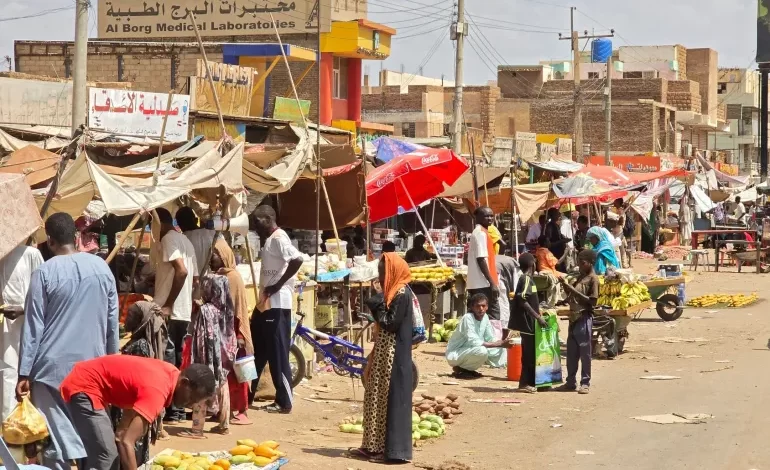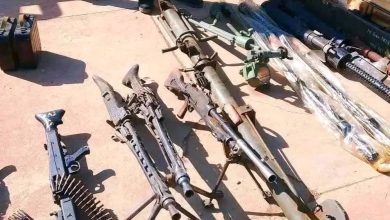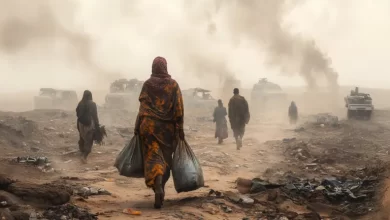This is How Khartoum Begins to Shake Off the Dust of War

Sudan Events – Agencies
In the Kalakla Market in Jebel Aulia, south of Sudan’s capital Khartoum, the city has recently begun to reclaim the bustle of life. Vendors and shoppers have returned, moving among stalls of fruits, vegetables, groceries, and cold drinks.
Along one of the market’s streets, a burned-out car—remnant of fierce fighting—still stands as a testament to the two-year conflict that engulfed the capital. However, Sudanese army forces have now regained control over most of Khartoum and pushed the Rapid Support Forces (RSF) to its outskirts.
Kalakla Market, one of the largest in southern Khartoum, has seen bakeries resume operations using solar energy due to ongoing power outages. Meanwhile, transportation between Kalakla in the far south and Omdurman in the west is steadily increasing.
The voices of street vendors bring back memories of the pre-war hustle that existed before conflict erupted in mid-April 2023 and still continues. Women selling food and coffee are a notable presence, lending the market a distinctive atmosphere, amid the visible return of residents to nearby neighborhoods like Tayba Al-Hasanab and Al-Shajara.
The movement of people and vehicles—some brand-new—reflects a broader image of the Sudanese capital, which in recent weeks seems like a phoenix rising from the ashes. For two years, war devastated its features and infrastructure, turning it from a lively oasis into a ghost town.
On the first anniversary of the war (April 2024), the International Organization for Migration estimated that around 10.7 million people had been displaced due to the conflict—9 million internally and 1.7 million to neighboring countries. At that time, data suggested that 90% of Khartoum’s population had fled.
More recently, with the army in control, the sounds of life have begun returning gradually to various parts of Khartoum, such as Bahri and East Nile. Markets, hospitals, and transport lines are resuming activity, and some universities have restarted classes after a two-year halt.
Omdurman Rebounds Fastest
In Omdurman—the largest of Khartoum’s cities and a major economic hub—life has returned more robustly, as it was quicker in resisting RSF forces. The army secured large parts of the city early on. Many residents have returned to their old neighborhoods such as Abu Rouf, Wad Al-Banna, Wad Nubawi, and Al-Hijra.
Several hospitals in Omdurman have resumed operations, including Omdurman Teaching Hospital, Al-Nau Hospital, and the Saudi Hospital, which welcomed patients in renovated buildings. A banner on one section of the Saudi Hospital credits its rehabilitation to the efforts of the Sudanese Doctors Association in the United States.
Khartoum State Health Minister Fath Al-Rahman Al-Amin told Al Jazeera Net that several hospitals had resumed services recently, especially in Omdurman, after being looted and destroyed by RSF forces.
According to the minister, the RSF destroyed hospitals across the capital, displaced medical staff, and stole equipment.
In the education sector, which is struggling to make up for the prolonged disruption, the University of Khartoum—Sudan’s largest and oldest—has reopened its Omdurman branches. The Faculty of Education is once again filled with students after a long absence. Several other universities have announced plans to resume classes soon.
Economically, Omdurman is the most active. Shops operate around the clock, and major markets such as the Omdurman Market and Sabreen Market are back in business. Streets are full of mobile vendors. Public transportation is functioning, and mosques are crowded again with the return of displaced residents.
Omar Ali, a trader at the Omdurman Market, told Al Jazeera Net that they reopened their shops despite the damage. “We restarted from scratch after all our goods and shops were looted,” he said.
Ali used to trade in foodstuffs before his shop was destroyed and the market largely burned. Although trade activity remains slow, he said the return to the Omdurman Market is steadily growing.
Economists estimate that the war has destroyed about 20% of Sudan’s capital stock—valued at roughly $600 billion—and eroded more than half of the country’s annual GDP, which averages around $33 billion.
These losses are attributed to the war erupting in Khartoum—the economic center of the country, accounting for 25% of Sudan’s economy—and spreading to other vital cities such as Nyala and Al-Fashir in Darfur, and Wad Madani in Al-Jazirah State, all key areas of agricultural and industrial production.
Bahri Breathes Again
Two years into the war, Khartoum Bahri (North Khartoum) was considered the most damaged among the capital’s cities. It had once hosted major markets, service institutions, educational centers, and transportation routes—all reduced to rubble.
However, Bahri, which lies north of Khartoum, has begun to rise again. Northern neighborhoods like Al-Droshab, Al-Samarab, Al-Kadro, and Al-Halfaya are reviving, especially with the return of electricity.
Commercial activity in central Bahri remains limited, but the government has started rehabilitating some healthcare facilities, including the previously destroyed Haj Al-Safi Hospital.
Transport between Bahri and Omdurman is currently the most active. Some factories, particularly those producing flour and pharmaceuticals, have resumed operations despite the extensive destruction of Bahri’s industrial zone.
Bridge Traffic Returns
Khartoum has more than ten bridges, including several over the Nile. During the war, traffic across these bridges halted completely, especially those connecting Bahri, Omdurman, Khartoum, East Nile, and Jebel Aulia.
Now that the army has regained control over more than 95% of the capital, bridge traffic is resuming. The White Nile Bridge, Al-Inqaz Bridge, and Halfaya Bridge—linking Omdurman and Bahri—are back in operation.
Traffic has also resumed on Al-Mak Nimr, Blue Nile, and Cooper bridges between Khartoum and Bahri, as well as the Soba and Manshiya bridges connecting Khartoum and East Nile.



